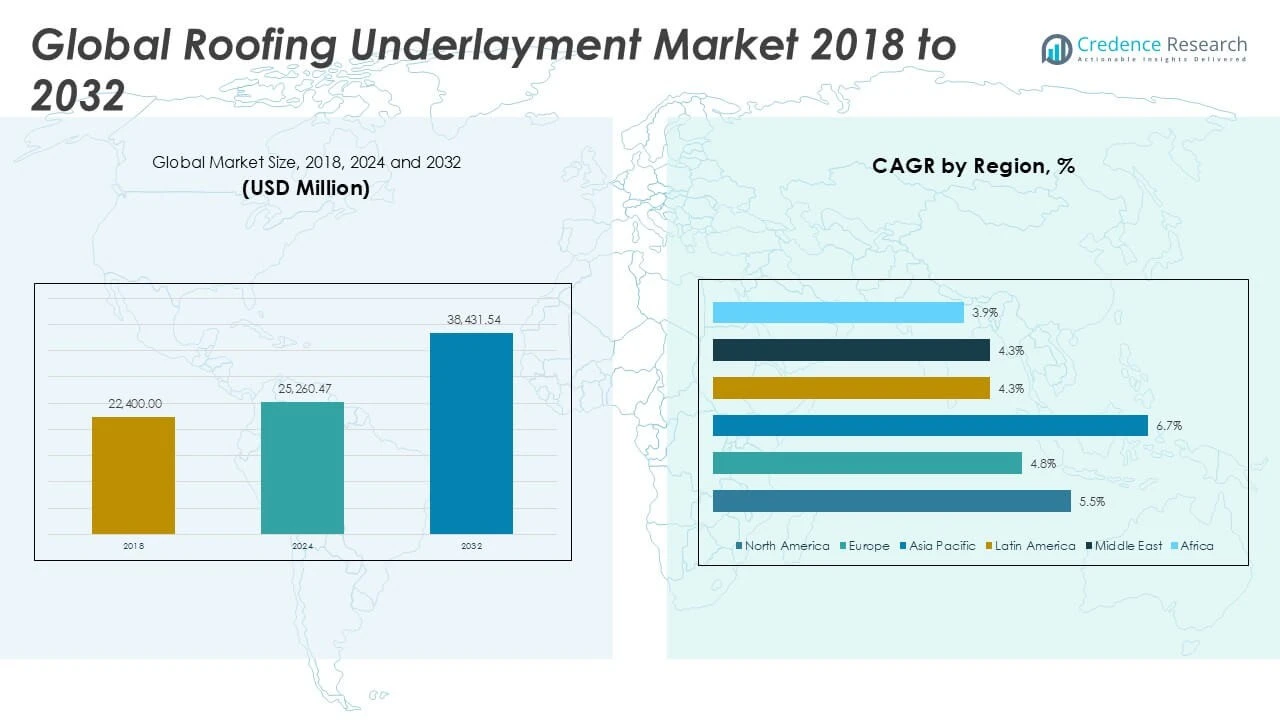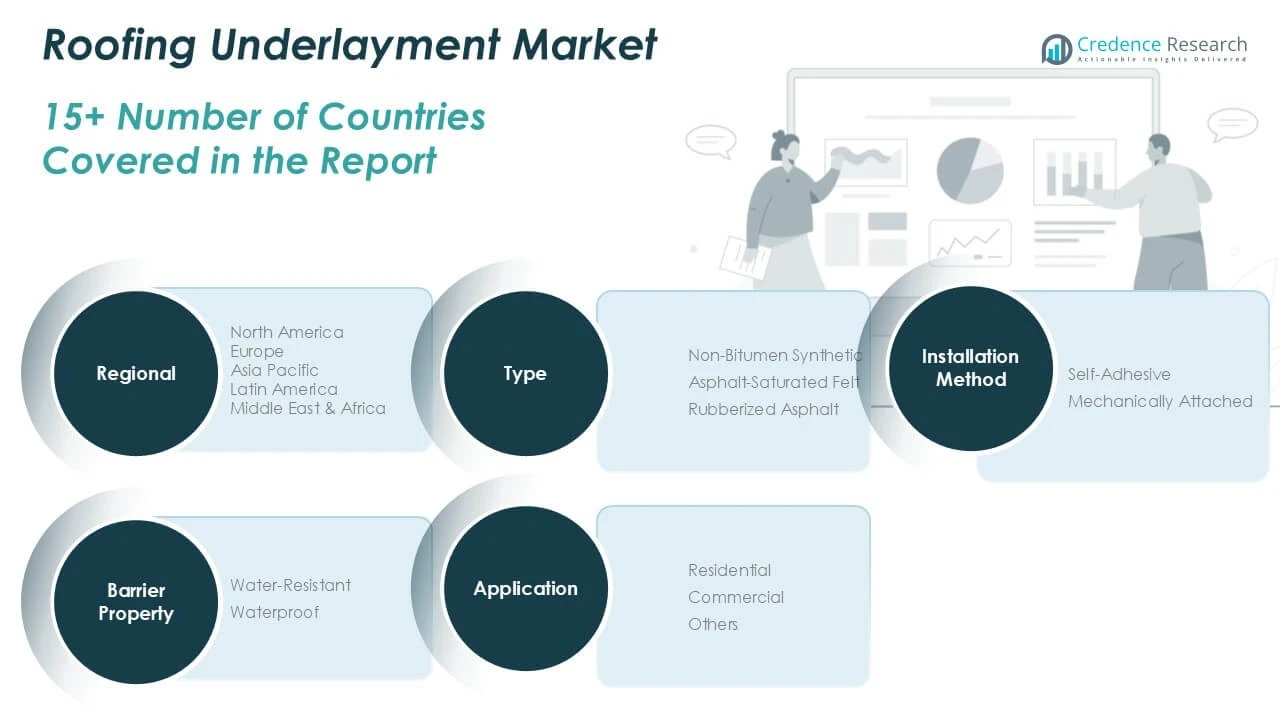CHAPTER NO. 1 : GENESIS OF THE MARKET
1.1 Market Prelude – Introduction & Scope
1.2 The Big Picture – Objectives & Vision
1.3 Strategic Edge – Unique Value Proposition
1.4 Stakeholder Compass – Key Beneficiaries
CHAPTER NO. 2 : EXECUTIVE LENS
2.1 Pulse of the Industry – Market Snapshot
2.2 Growth Arc – Revenue Projections (USD Million)
2.3. Premium Insights – Based on Primary Interviews
CHAPTER NO. 3 : ROOFING UNDERLAYMENT MARKET FORCES & INDUSTRY PULSE
3.1 Foundations of Change – Market Overview
3.2 Catalysts of Expansion – Key Market Drivers
3.2.1 Momentum Boosters – Growth Triggers
3.2.2 Innovation Fuel – Disruptive Technologies
3.3 Headwinds & Crosswinds – Market Restraints
3.3.1 Regulatory Tides – Compliance Challenges
3.3.2 Economic Frictions – Inflationary Pressures
3.4 Untapped Horizons – Growth Potential & Opportunities
3.5 Strategic Navigation – Industry Frameworks
3.5.1 Market Equilibrium – Porter’s Five Forces
3.5.2 Ecosystem Dynamics – Value Chain Analysis
3.5.3 Macro Forces – PESTEL Breakdown
3.6 Price Trend Analysis
3.6.1 Regional Price Trend
3.6.2 Price Trend by product
CHAPTER NO. 4 : KEY INVESTMENT EPICENTER
4.1 Regional Goldmines – High-Growth Geographies
4.2 Product Frontiers – Lucrative Product Categories
4.3 Application Sweet Spots – Emerging Demand Segments
CHAPTER NO. 5: REVENUE TRAJECTORY & WEALTH MAPPING
5.1 Momentum Metrics – Forecast & Growth Curves
5.2 Regional Revenue Footprint – Market Share Insights
5.3 Segmental Wealth Flow – Type & Application Revenue
CHAPTER NO. 6 : TRADE & COMMERCE ANALYSIS
6.1.Import Analysis by Region
6.1.1. Global Roofing Underlayment Market Import Revenue By Region
6.2.Export Analysis by Region
6.2.1. Global Roofing Underlayment Market Export Revenue By Region
CHAPTER NO. 7 : COMPETITION ANALYSIS
7.1.Company Market Share Analysis
7.1.1. Global Roofing Underlayment Market: Company Market Share
7.2. Global Roofing Underlayment Market Company Revenue Market Share
7.3.Strategic Developments
7.3.1.Acquisitions & Mergers
7.3.2. New Product Launch
7.3.3. Regional Expansion
7.4. Competitive Dashboard
7.5. Company Assessment Metrics, 2024
CHAPTER NO. 8 : ROOFING UNDERLAYMENT MARKET – BY TYPE SEGMENT ANALYSIS
8.1.Roofing Underlayment Market Overview by Type Segment
8.1.1. Roofing Underlayment Market Revenue Share By Type
8.2.Non-Bitumen Synthetic
8.3. Asphalt-Saturated Felt
8.4. Rubberized Asphalt
CHAPTER NO. 9 : ROOFING UNDERLAYMENT MARKET – BY APPLICATION SEGMENT ANALYSIS
9.1.Roofing Underlayment Market Overview by Application Segment
9.1.1. Roofing Underlayment Market Revenue Share By Application
9.2. Residential
9.3. Commercial
9.4. Others
CHAPTER NO. 10 : ROOFING UNDERLAYMENT MARKET – BY INSTALLATION METHOD SEGMENT ANALYSIS
10.1.Roofing Underlayment Market Overview by Installation Method Segment
10.1.1. Roofing Underlayment Market Revenue Share By Installation Method
10.2. Self-Adhesive
10.3. Mechanically Attached
CHAPTER NO. 11 : ROOFING UNDERLAYMENT MARKET – BY BARRIER PROPERTY SEGMENT ANALYSIS
11.1.Roofing Underlayment Market Overview by Barrier Property Segment
11.1.1. Roofing Underlayment Market Revenue Share By Barrier Property
11.2.Water-Resistant
11.3.Waterproof
CHAPTER NO. 12 : ROOFING UNDERLAYMENT MARKET – REGIONAL ANALYSIS
12.1.Roofing Underlayment Market Overview by Region Segment
12.1.1. Global Roofing Underlayment Market Revenue Share By Region
12.1.2.Regions
12.1.3.Global Roofing Underlayment Market Revenue By Region
12.1.4.Type
12.1.5.Global Roofing Underlayment Market Revenue By Type
12.1.6.Application
12.1.7. Global Roofing Underlayment Market Revenue By Application
12.1.8.Installation Method
12.1.9. Global Roofing Underlayment Market Revenue By Installation Method
12.1.10.Barrier Property
12.1.11. Global Roofing Underlayment Market Revenue By Barrier Property
CHAPTER NO. 13 : NORTH AMERICA ROOFING UNDERLAYMENT MARKET – COUNTRY ANALYSIS
13.1.North America Roofing Underlayment Market Overview by Country Segment
13.1.1.North America Roofing Underlayment Market Revenue Share By Region
13.2.North America
13.2.1.North America Roofing Underlayment Market Revenue By Country
13.2.2.Type
13.2.3.North America Roofing Underlayment Market Revenue By Type
13.2.4.Application
13.2.5.North America Roofing Underlayment Market Revenue By Application
13.2.6.Installation Method
13.2.7.North America Roofing Underlayment Market Revenue By Installation Method
13.2.8.Barrier Property
13.2.9.North America Roofing Underlayment Market Revenue By Barrier Property
13.3.U.S.
13.4.Canada
13.5.Mexico
CHAPTER NO. 14 : EUROPE ROOFING UNDERLAYMENT MARKET – COUNTRY ANALYSIS
14.1. Europe Roofing Underlayment Market Overview by Country Segment
14.1.1. Europe Roofing Underlayment Market Revenue Share By Region
14.2.Europe
14.2.1.Europe Roofing Underlayment Market Revenue By Country
14.2.2.Type
14.2.3.Europe Roofing Underlayment Market Revenue By Type
14.2.4.Application
14.2.5. Europe Roofing Underlayment Market Revenue By Application
14.2.6.Installation Method
14.2.7. Europe Roofing Underlayment Market Revenue By Installation Method
14.2.8.Barrier Property
14.2.9. Europe Roofing Underlayment Market Revenue By Barrier Property
14.3.UK
14.4.France
14.5.Germany
14.6.Italy
14.7.Spain
14.8.Russia
14.9. Rest of Europe
CHAPTER NO. 15 : ASIA PACIFIC ROOFING UNDERLAYMENT MARKET – COUNTRY ANALYSIS
15.1.Asia Pacific Roofing Underlayment Market Overview by Country Segment
15.1.1.Asia Pacific Roofing Underlayment Market Revenue Share By Region
15.2.Asia Pacific
15.2.1. Asia Pacific Roofing Underlayment Market Revenue By Country
15.2.2.Type
15.2.3.Asia Pacific Roofing Underlayment Market Revenue By Type
15.2.4.Application
15.2.5.Asia Pacific Roofing Underlayment Market Revenue By Application
15.2.6.Installation Method
15.2.7.Asia Pacific Roofing Underlayment Market Revenue By Installation Method
15.2.8.Barrier Property
15.2.9.Asia Pacific Roofing Underlayment Market Revenue By Barrier Property
15.3.China
15.4.Japan
15.5.South Korea
15.6.India
15.7.Australia
15.8.Southeast Asia
15.9. Rest of Asia Pacific
CHAPTER NO. 16 : LATIN AMERICA ROOFING UNDERLAYMENT MARKET – COUNTRY ANALYSIS
16.1.Latin America Roofing Underlayment Market Overview by Country Segment
16.1.1.Latin America Roofing Underlayment Market Revenue Share By Region
16.2. Latin America
16.2.1. Latin America Roofing Underlayment Market Revenue By Country
16.2.2.Type
16.2.3. Latin America Roofing Underlayment Market Revenue By Type
16.2.4.Application
16.2.5.Latin America Roofing Underlayment Market Revenue By Application
16.2.6.Installation Method
16.2.7.Latin America Roofing Underlayment Market Revenue By Installation Method
16.2.8.Barrier Property
16.2.9.Latin America Roofing Underlayment Market Revenue By Barrier Property
16.3.Brazil
16.4.Argentina
16.5.Rest of Latin America
CHAPTER NO. 17 : MIDDLE EAST ROOFING UNDERLAYMENT MARKET – COUNTRY ANALYSIS
17.1.Middle East Roofing Underlayment Market Overview by Country Segment
17.1.1.Middle East Roofing Underlayment Market Revenue Share By Region
17.2.Middle East
17.2.1. Middle East Roofing Underlayment Market Revenue By Country
17.2.2.Type
17.2.3.Middle East Roofing Underlayment Market Revenue By Type
17.2.4.Application
17.2.5.Middle East Roofing Underlayment Market Revenue By Application
17.2.6. Installation Method
17.2.7.Middle East Roofing Underlayment Market Revenue By Installation Method
17.2.8. Barrier Property
17.2.9.Middle East Roofing Underlayment Market Revenue By Barrier Property
17.3.GCC Countries
17.4. Israel
17.5. Turkey
17.6.Rest of Middle East
CHAPTER NO. 18 : AFRICA ROOFING UNDERLAYMENT MARKET – COUNTRY ANALYSIS
18.1. Africa Roofing Underlayment Market Overview by Country Segment
18.1.1.Africa Roofing Underlayment Market Revenue Share By Region
18.2. Africa
18.2.1.Africa Roofing Underlayment Market Revenue By Country
18.2.2.Type
18.2.3.Africa Roofing Underlayment Market Revenue By Type
18.2.4.Application
18.2.5. Africa Roofing Underlayment Market Revenue By Application
18.2.6.Installation Method
18.2.7. Africa Roofing Underlayment Market Revenue By Installation Method
18.2.8.Barrier Property
18.2.9. Africa Roofing Underlayment Market Revenue By Barrier Property
18.3. South Africa
18.4.Egypt
18.5.Rest of Africa
CHAPTER NO. 19 : COMPANY PROFILES
19.1. GAF Materials Corporation
19.1.1.Company Overview
19.1.2.Product Portfolio
19.1.3.Financial Overview
19.1.4.Recent Developments
19.1.5.Growth Strategy
19.1.6.SWOT Analysis
19.2. Owens Corning
19.3. Johns Manville
19.4. IKO Industries Ltd.
19.5. Roofing Components International
19.6. MFM Building Products Corp.
19.7. Carlisle SynTec Systems
19.8. DuPont de Nemours, Inc.
19.9.3M
19.10. SOPREMA
19.11. BMI Group
19.12. Atlas Roofing Corporation
19.13. TAMKO Building Products LLC
19.14. Polyglass USA, Inc.









